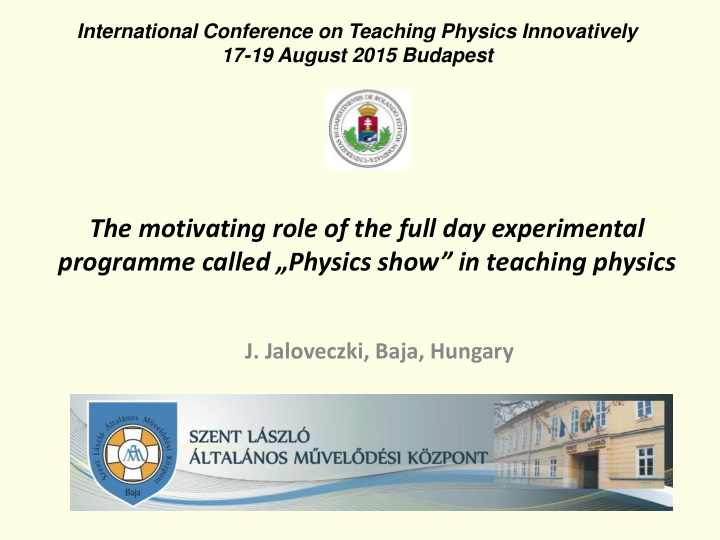



International Conference on Teaching Physics Innovatively 17-19 August 2015 Budapest The motivating role of the full day experimental programme called „Physics show” in teaching physics J. Jaloveczki, Baja, Hungary
Scheme • Describing our Physics show through questions and answers • Experiments • How the Physics show can motivate learning physics
Questions - Answers • What is physics show? • It’s a round the day presentation of physics experiments. • Where and when can it be seen? • In our school, in Szent László Educational Center, usually in late April. • Who organizes it? • Students from the study group, from the science workshop and teachers. • Who can visit? • Anybody interested.
A thermo - acoustic tube
Questions - Answers • How and when do we prepare for the show? • In study groups, in science workshops, in the afternoons and sometimes in classes. • How do we invite visitors? We advertise it in schools in town and in nearby villages, in papers, in the local radio and TV and on the Web. The media usually make a report on the spot on the day of the show.
Hydrogen gun The best ‘pop’ is usually achieved with a mixture containing 20 - 40 % by volume of hydrogen
Bubbles filled with hydrogen • Hydrogen gas from hydrochloric acid with granulated zinc. Zn 2HCl ZnCl H aq 2(aq ) 2(g ) • blow bubbles on the palm. • The wet palm will not get burnt due to the high heat of water evaporation and specific heat.
Questions - Answers • Where do the experiments come from? • From books, from the Web. • What kind of experiments have been so far? • Mechanics, electricity, magnetic phenomena, light and heat phenomena, nuclear or atomic physics, chemical and biological phenomena. What are the main reasons for choosing certain experiments? Curiosity, easiness to carry out, cheapness.
A carbon graphite lamp • A pencil refill between the two alligator clips. • Increase current in the circuit and the pencil refill begins to glow. This happens because the electricity heats the graphite refill to an incredible temperature. The carbon reacts with oxygen.
Questions - Answeres • What does the audience consist of? • Our students, students from the schools in the area, their teachers, children from the kindergarten. • How do the visitors react to the show? • We have very positive feedbacks. They expect to have it every year and encourage us to organize it again.
Elephant toothpaste • The basic idea is this: first mix concentrated hydrogen peroxide with some liquid soap. • Then add a catalyst (potassium iodide ) to make the hydrogen peroxide decompose really quickly . • Hydrogen peroxide breaks down into oxygen and water. • The oxygen gushing out is what makes the soap bubbles move. A burning match indicates the oxygen. 2H O 2H O O 2 2 2 2
Conductivity of glass • Essence: – Lights in serial connection, one of which has been broken and the tungsten filament removed – This light is heated in closed circuit – The glass having been melted permanently the other light starts glowing again. Its conductivity remains the same until is melted.
Summary • How does this event motivate students? It arouses their interest towards the phenomena and the experiments. They are open to recognise interesting experiments found on the Web. Their communication is improving. They are getting better at experimenting and at manual skills. They get more intense, certain rules and conceptions get meaningful for them. They enjoy showing and explaining experiments to visitors, their attitude towards the subject improves.
Last experiment: burning money • Alcohol burns with an almost invisible blue flame. One trick is to add a little table salt to the water-alcohol mixture to make the flame more visible. Rule #1: Never use your own money! Mixture: 50 ml of 95% ethyl alcohol with 50 ml of water or 70 ml of rubbing alcohol (usually 70%) with 30 ml of water
• Without limitation a few books (in Hungarian) we have already used for the shows: • Juhász A.: Fizikai kísérletek gyűjteménye 1.,2.,3., Arkhimédész Bt. - Typotex Kiadó, Bp . • C. Siddons: Fizikai kísérletek, Novotrade kiadó, Sulikomp • And a few links we have taken ideas to the experiments from: • http://www.stevespanglerscience.com/lab/experiments • http://www.indavideo.hu/video/Vilagito_Ceruza • http://www.arvindguptatoys.com/electricity-magnetism.php • http://scifun.chem.wisc.edu/homeexpts/lumpyliquids.ht • http://www.fizikashow.hu/
Thank you for your kind attention!
Recommend
More recommend